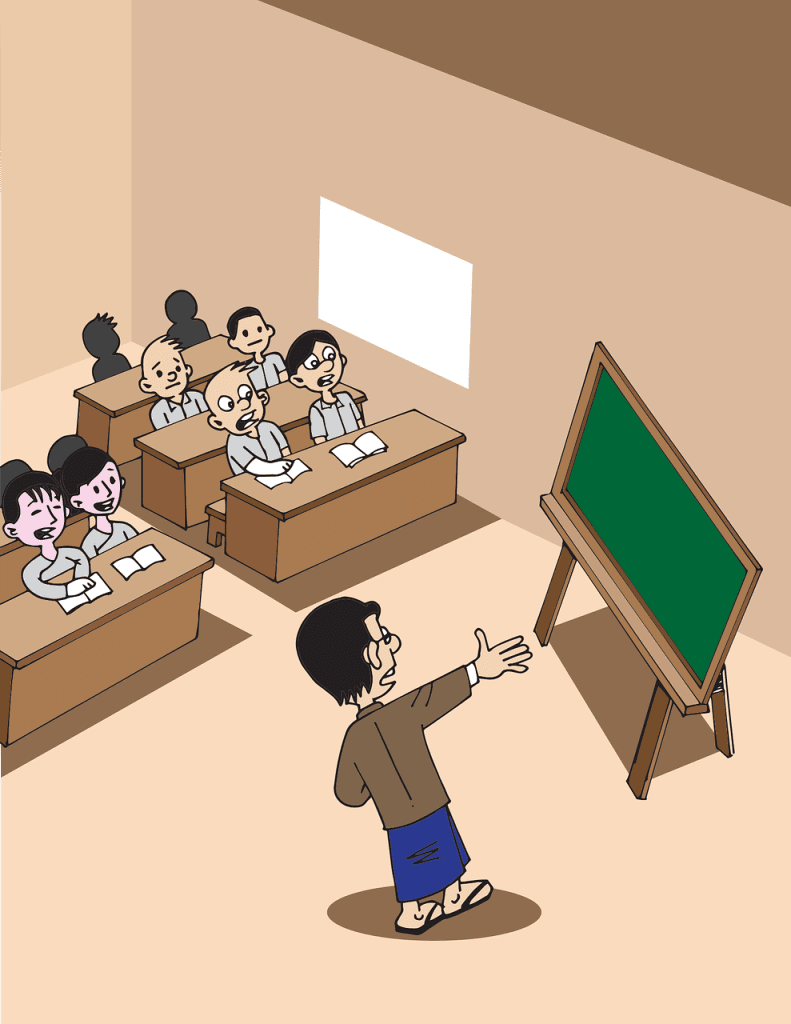Many corporate trainers find it difficult to hold their hands in place when giving a lecture or guiding an online self-learning course. This blog post will show you how to use Trainer Stance to strategically put your hand gestures and movements so that they don’t get in the way of your delivery or your trainees’ learning.

What is trainer stance?
Trainer stance is the way a trainer stands inside the classroom in-front of the trainees. This is not very important if you are handling an online training session; however, if you are handling a classroom session or delivering a lecture, your body language matters a lot to your trainees.
After a thorough research on this topic, we have come to the conclusion that a certain posture and gesture during the classroom training session helps build confidence in the trainees. Trainer stance is all about that posture and gesture which we will be discussing in this article in details.
Different types of Hand Gestures
Here is a list of different types of posture that we have observed and analyzed what they actually mean.
Crossed Arms

Did you ever come across a situation where trainees were afraid to approach you for any reason? Maybe you should look at the posture that you are standing on. A lot of us have a habit of crossing our arms while training a class full of people. This is ideally not a good idea as this kind of posture sends a negative vibe of less confidence to your audience and makes you non-approachable.
Closed Fist
A closed fist gesture can be used to indicate determination or resolve. It can also be used to emphasize a point or to convey a sense of urgency. However, using a closed fist during a classroom training sends a signal to your trainees that you might not be open to feedback or suggestions. This will hold them back while asking questions and clarifying their concerns.
Palm Down

A palm-down gesture can be used to signal authority or control. It can also be used to indicate a need for order or discipline. This gesture specially can be very useful when your class is about to go out of your control. This gesture helps you to send a signal to your trainees to calm down and settle for the next session.
Hands in Pockets

The hands in pockets gesture during training can send a negative message to the trainees. It can indicate that the trainer is disinterested, unprepared, or lacking in confidence. The gesture can also be perceived as unprofessional, and it may undermine the trainer’s authority in the eyes of the trainees.
It may draw their attention away from the training content and towards the trainer’s body language, which can interfere with their ability to learn and retain information. Instead of keeping your hands in your pockets, try to use hand gestures that are more positive and engaging. For example, you could use open hand gestures to convey openness and honesty,or thumbs up gestures to indicate approval or agreement.
Open hand
The open hand gesture is one of the most positive and welcoming hand gestures that a trainer can use during training. This gesture is often used to indicate openness, honesty, or acceptance, and it can be very effective at creating a positive and engaging training environment.
When a trainer uses open hand gestures during training, it sends a message to the trainees that they are approachable, trustworthy, and willing to listen. This can help to build rapport and trust between the trainer and the trainees, which is essential for effective learning and development.

In addition to its positive connotations, the open hand gesture can also be used to emphasize key points or to draw attention to specific items or concepts. For example, a trainer might use an open hand gesture to point to a diagram or chart on a whiteboard, or to emphasize the importance of a particular concept or idea.
To use the open hand gesture effectively during training, it’s important to be mindful of your body language and the messages that you are sending to your trainees. Try to use open hand gestures frequently throughout the training session, and use them in combination with other positive body language cues, such as smiling, nodding, and maintaining eye contact.
How to point
Pointing is a common hand gesture used by trainers during classroom training to draw attention to specific items or concepts. However, it’s important to use this gesture in a way that is clear, precise, and respectful of the trainees. Here are some tips for pointing effectively during classroom training:

- Use an open hand gesture: When pointing, use an open hand gesture rather than a closed fist. This is a more welcoming and respectful gesture that can help to build rapport with the trainees.
- Use your whole hand: When pointing, use your whole hand rather than just your index finger. This can help to avoid confusion and ensure that your trainees are clear about what you are pointing to.
- Point clearly and precisely: When pointing, be sure to point clearly and precisely to the item or concept that you want to highlight. This can help to avoid confusion and ensure that your trainees understand what you are trying to convey.
- Avoid pointing directly at individuals: When pointing, avoid pointing directly at individuals as this can be seen as confrontational or aggressive. Instead, point to the area around the individual or use a more general gesture to indicate the direction of the item or concept.
- Use pointing sparingly: While pointing can be an effective way to draw attention to specific items or concepts, it’s important to use this gesture sparingly. Overusing pointing can be distracting and may undermine the effectiveness of your training.
Overall, pointing can be a useful tool for trainers during classroom training, but it’s important to use this gesture in a way that is clear, precise, and respectful of your trainees. By following these tips, you can point effectively and ensure that your trainees are engaged and attentive throughout your training session.
What to do with my hands when I am not speaking

Many of the trainers find it difficult to understand what to do with their hands when they are not talking to their audience. Many of us, have a tendency to keep the hands inside the pockets or put them behind our body. Some of the trainers that we have observed, picks up a pen, marker or mobile phone and starts fidgeting with it. All of these gestures while make you comfortable with your hands, also make your trainees distracted.
The best place to keep your hands during a non-verbal session where you are just listening to the trainees is to cross your fingers of both of the arms and keep them in front of you.
How far shall I Strech my hands
Well, it is a common tendency to use hand gestures to express severity of a situation and training is no exception to that; however, sometimes, as a trainer we pick up the stretching of hand gestures as a habit and we keep on doing that for everything. This distracts the trainees a lot during any session and also hampers the respect for the trainer. In worst case scenarios, the trainees will start mocking the trainer and the entire classroom control is tossed away.

To avoid distraction, a trainer should create an imaginary box in the air and keep the hands inside the box when they are talking or to close
Conclusion
In conclusion, hand gestures are an important form of nonverbal communication that can be used to convey emotions, ideas, and messages. Understanding the meanings of different hand gestures can help you communicate effectively and avoid misunderstandings. However, it’s important to remember that hand gestures can have different meanings in different cultures, so it’s always a good idea to be aware of cultural differences when communicating with people from different backgrounds.

![The Power of Storytelling in Corporate Training: Igniting Success and Inspiring Growth [2023]](https://trainercentric.com/wp-content/uploads/2023/06/storytelling-1024x576.jpg)

